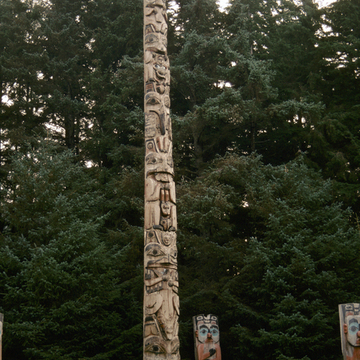The Sitka National Historical Park has an impressive collection of totem poles and house posts. Although detached from their houses and their history, the poles are an aesthetic achievement within themselves, and a remnant of an important aspect of Native architecture. Although many have been replicated, no original totem poles or house posts in Alaska remain on their original sites with their traditional dwellings. Although the park has some fragments of older poles in its collection, all of the poles displayed outdoors date from the 1930s or later.
Totem poles, which are usually about 30 feet tall (although the tallest here is 55 feet), are carved, freestanding cedar or spruce poles, representing a story or commemorating an individual or event. They were made by both the Haida and the southern Tlingit. Both Haida and Tlingit placed house posts—carved planks—on the outside corners of their houses or used them as interior structural members. Memorial or mortuary poles might have one image at the top relating to the clan of the person thus memorialized. Other poles and posts had a progression of carved or painted images, which do not convey a story as much as refer to one that is known by the intended viewers.
The poles at Sitka National Historical Park originated with a group amassed by Gov.
As the poles stand outdoors and are planted in the ground, they are subject to deterioration. In 1939–1940, the U.S. government supported a program to replicate poles, employing Native carvers with Works Progress Administration and Civilian Conservation Corps funds. Seven of these reproduction poles survive. Additional poles have been replicated by master carvers in the last decade or two. The National Park Service held a design competition for a bicentennial pole in 1976; it is the only contemporary piece.
The outdoor poles are set in a dense grove of mature spruce, lining a path along the shoreline that leads to the site of the Tlingit fort and 1804 battleground. The serenity of the location provides a romanticized setting in which to examine and contemplate these always intriguing and frequently haunting images.

